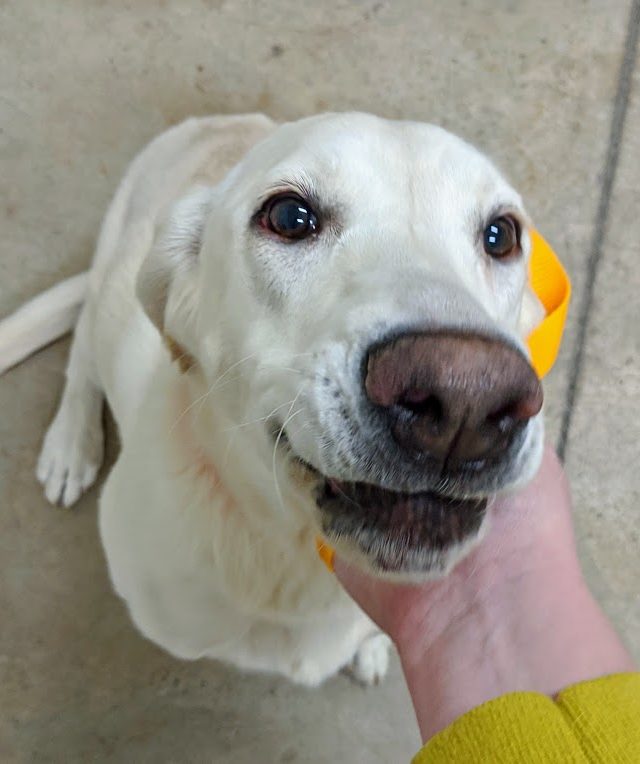Vets, licenses, and tags – oh, my!
It’s Responsible Pet Owners’ Month, and while being a responsible pet owner can be work-intensive, Fido and Fluffy stay SO much healthier when we take these steps. Because there are MANY ways to define what “responsible” is, below are a few guidelines (NOT a complete list) to follow to ensure you, as a pet owner, are keeping animals and the community safe:
Getting the medical care your animal needs
This includes spaying and neutering your pets (which we will discuss later on in this blog), vaccinating them to prevent them and other community pets from contracting preventable diseases, annual wellness exams to ensure they are healthy, and getting any notable problems with your pet addressed.
Take sweet Gemma, now named Grace, as an example. This 6-month-old yellow lab came to our Pueblo shelter as a stray.
When she arrived, she had a limp and didn’t like to put weight on her right, hind leg. So, our veterinary team took a closer look and met with Colorado Canine Orthopedics for advice. They determined the injury was an old one, and because it went untreated for so long, her best bet at a full life would be to amputate her leg.
That’s exactly what we did, and, afterwards, you could visibly see the relief in Grace’s face and demeanor. Instead of being shy and timid, she was bounding around and rolling over for belly rubs! She was quickly adopted into a new, loving family.
As providers of Animal Law Enforcement (ALE) for the communities we serve, we often see cases like Grace’s, where animals with illness and injury go untreated. When there is sufficient evidence, we can charge the owners of these animals with Animal Cruelty, to prevent them from doing this to other animals in the future.

Spaying or neutering your fur baby
About 6.5 million animals enter a shelter in the US every year, and in just 2019, HSPPR served 23,665 of them. One of the root causes of this is unwanted litters, which result in pet overpopulation. Let’s take the average domestic cat as an example. A female cat can have, on average, two to five litters of three to five kittens each, EVERY YEAR. Over the course of a 15-year life span…that’s A LOT of kittens – about 180. Now, imagine each of those 180 cats having another 180 cats and…well, you get the picture. It’s a lot of cats, and there simply aren’t enough homes for all of them, resulting in overfilled shelters. The solution? Fix your pet! HSPPR offers low-cost spay and neuter surgeries, and every pet who is adopted from our shelter is fixed before leaving our front doors.
*Pssst…Speaking of cat overpopulation, got a lot of cats in your neighborhood? Join our community Trap-Neuter-Return (TNR) program to help safely control the population!
Another reason to spay/neuter is to avoid illnesses like testicular cancer, ovarian cancer and pyometra (where the uterus fills with fluid and pus). Maxine the pup is the perfect example as to why spaying a dog can be a life-saving procedure.
In late December, our Pueblo Animal Law Enforcement team brought in a stray dog in distress, whom we named Maxine. Upon examination, HSPPR staff veterinarian Dr. Patti realized she had severe pyometra, which is a life-threatening condition. When Dr. Patti performed the hysterectomy, she found Maxine’s uterus was so infected, it weighed two pounds, when Maxine only weighed seven.
Unfortunately, we were too late, and the infection went septic, spreading the bacteria throughout Maxine’s body, and shutting down her organs until she passed away. We were so saddened by this loss, but we are compelled to use this as the prime example as to why spaying and neutering your pet is so important.

Making sure your pets get proper mental and physical exercise
We hear it all the time – my dog keeps chewing things up, my cat is house soiling, etc. But, our Pueblo Behavior Programs Manager, Miguel Gonzalez, says “These are signs your pet isn’t getting the stimulation he or she needs. Instead of focusing on the behavior you don’t want, focus on the root issue. Use toys, like Kongs, snuffle mats and strings, to keep your animal mentally and physically engaged. Just like humans, animals get restless if they aren’t getting enough exercise or if they get bored. Address these issues, and you’ll often find you have an incredible pet!”
Ensuring your pets are licensed and have collars and tags
As an animal welfare organization, we prioritize public safety, so we always urge everyone to keep their pets contained and out of harm’s way. Keep gates closed, keep dogs that may bite appropriately contained, have a leash on your dog at all times for their safety and the safety of the public, and keep an eye on the whereabouts of your kitties!
However, we also recognize that pet owners are human, in every sense of the word. Accidents happen, and pets get loose. That’s why we strongly urge everyone to license and microchip their pets, and ensure they are always wearing identifying tags. In just the year 2019, HSPPR reunited 4,729 lost pets with their owners. But, if pets are properly registered and tagged, this number can greatly increase, and we can prevent many of these animals from ever having to enter our shelters in the first place!
*Note: If you have lost or found a pet, please fill out a lost or found report on our website so that we can work to get pets and people reunited!
And SO. MUCH. MORE.
There is so much more to being a responsible pet owner than we can possibly squeeze into a single blog post, but we will leave you with one last thought: Part of responsible pet ownership is understanding when you are unable to meet your pets’ needs. Whether you have your hands full and no time, or you are struggling financially, or you lost your home or… the list goes on, we don’t ever judge for surrendering an animal to our shelter. In fact, we are grateful you do. By doing so, you are ensuring your pet has a second chance at a loving and happy home. And that’s what being a responsible pet owner is all about.
#HappyTailsHappyHearts







